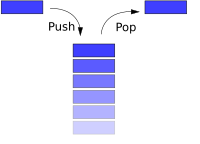Stack (Abstract Data Type)

Simple representation of a
stack
In computer science, a stack is
a last in, first out (LIFO) abstract data
type and linear data structure. A stack can have any abstract data
type as an element,
but is characterized by two fundamental operations, called push and pop.
The push operation adds a new item to the top of the stack, or initializes the
stack if it is empty. If the stack is full and does not contain enough space to
accept the given item, the stack is then considered to be in an overflow state. The pop operation removes an item from the top of
the stack. A pop either reveals previously concealed items, or results in an
empty stack, but if the stack is empty then it goes into underflow state (It
means no items are present in stack to be removed).
A stack is
a restricted data structure, because only a small number of
operations are performed on it. The nature of the pop and push operations also
means that stack elements have a natural order. Elements are removed from the
stack in the reverse order to the order of their addition: therefore, the lower
elements are those that have been on the stack the longest.
Notes
continue in the next blog:
History
of Stack (Abstract Data Type (ADT))
J.W. PRODUCTION